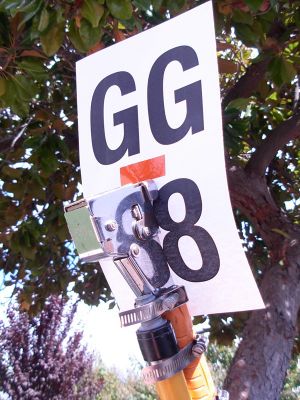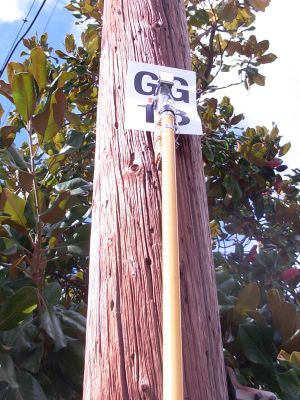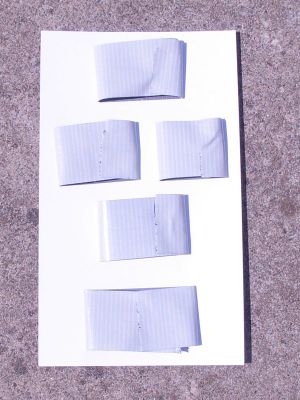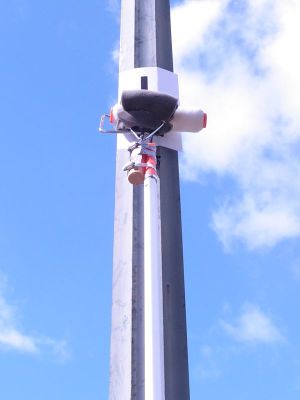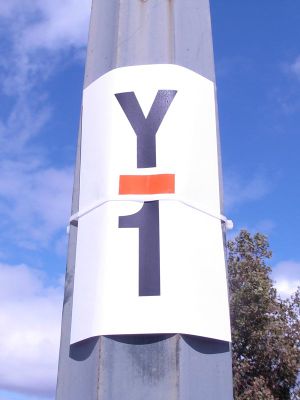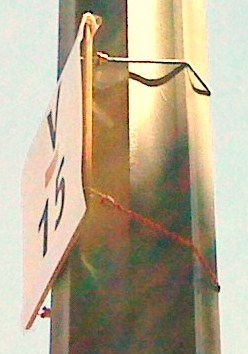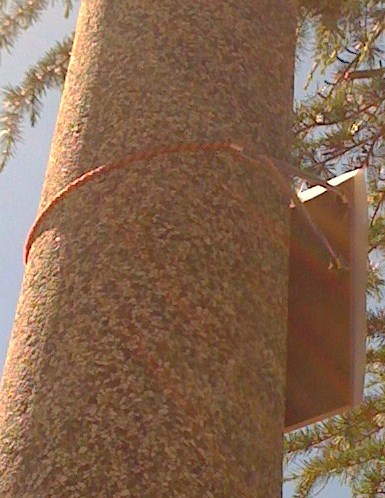Coursemarker Guidelines
Rallye Preparation
During preparation (writing) of the rallye, as you drive the route, select exactly which poles will be used for CMs. It matters a lot whether the CM will be beyond an intersection or not, as the SUPP (or SI) may need to refer to the 1st OPP or the 2nd OPP. But some rallyists will neglect to count the intersection "at" the CM anyway.
Consider whether the pole will be lit by a street light (generally a good thing at night), whether it is obscured by trees or other landscaping (generally a bad thing), and from which directions the coursemarker will be visible. Coursemarkers should be visible when driving by (of course), but usually not visible from the other side (telegraphs its existence) or from the intersection at which a decision should be made. Normally, a rallyist should have to decide what to do before seeing the CM(s). Although sometimes, negative CMs are left more visible to sucker rallyists (a "big, juicy" CM).
Note that some types of poles are known to cause problems. It may be best to avoid using neighborhoods with these kinds of poles:
- concrete poles, which make it difficult to attach coursemarkers reliably, though bungees can be made to work
- light poles with the light straight up above the pole (rather than offset from the pole by a horizontal support), because at night the light will be so bright that the nearby coursemarker won't be easily read. Of course they are fine during full daylight.
Record what kind of pole it is, so you know how you'll need to attach the coursemarker, so the CM can be prepared before your arrival at the pole.
Making Coursemarkers
Page Size and Layout
TRC coursemarkers are normally printed on 8½ × 11-inch card stock. You may wish to trim CMs to make them narrower. Narrower CMs are less visible from the back of the pole, and they may blow down less often in storms because they catch less of the wind. If you trim some, but not all, of your CMs, then clarify in the GIs that a narrower or wider CM is not a gimmick. Trained to be suspicous, rallyists will question any deviation from the sample CM(s) at the start.
Use a laser printer. Coursemarkers printed on inkjet printers become illegible when they get wet and the ink runs.
Set the font size "huge". Something in the range of 300 points is a good starting place, but then you'll need to tweak because the best font size varies with the font. (A standard 8½ × 11-inch page is 612 × 792 points.) Get as large as you can. Most people don't realize how large street signs really are.
Set the margins very small, and be prepared to fiddle with the paragraph/line spacing. Adjusting the letter spacing can help make double letters (especially "VV") easier to read.
Font Choices
Feel free to play around and come up with thematic fonts on your CMs. It will add a nice touch. Some important criteria are:
- Legible at a distance
- Wide stroke helps
- Serif fonts may help
- Busy display fonts (e.g., Old English) are hard to read
- Double-letters (especially WW, MM, OO, etc.) fit the page width
- Similar letters/numbers are easily differentiated
- 1, I and J (serif fonts may help)
- 0, O and Q
- VV and W (an extra space in "V V" helps, but shouldn't be necessary)
These fonts have worked well:
- Swiss 721 BT
- Goudy Extra Bold
- OCR-A Extended
- Copperplate
These fonts have worked OK, but not great:
- New Century Schoolbook (strokes are too light, VV runs into W space)
- Helvetica (strokes again too light, no serifs make distinguishing some letters harder)
- Helvetica Narrow Bold (VV and II look better with a space between the letters, I has no serifs and could be a 1; however WW fits the page even at 360pt)
- Comic Sans (some characters came out funny, but I don't remember what)
Some fonts that give trouble:
- Gill Sans (1, I indistinguishable in some larger sizes)
- Arial (ditto)
- Various weird titling fonts for various reasons
Open Office Spreadsheet
Using StarOffice or free OpenOffice software or similar [www.libreoffice.org LibreOffice] Dean used an OpenDocument Spreadsheet (ODS) file with two columns: one for the the letters and one for the numbers. Both were in 96-point (the largest available) bold and both used Vertical orientation Middle, and both used text direction 90 degrees (so V looked like >). The letters used Horizontal orientation right. The numbers used Horizontal orientation left. Ideally, the CMs are produced in marker visitation order.
Dean then set the Page Format (Sheet Tab) to Scale choice "reduce/enlarge printout" at the maximum size that fit on the page (about 300%). Enabling View->Page Break Preview allows easy confirmation that only one marker will print on each page.
Open Office Text Document
Using free OpenOffice software, Darin used an OpenDocument Text (ODT) file. He centered everything horizontally, set the font to Arial Narrow, bold, and 360pt (5in), and then set the Line Spacing (right-click > Paragraph... > Indents & Spacing) to Proportional of 90%. He then used a paper cutter to trim ¾" off each side of the CMs, making them 1½" narrower overall.
The line breaks and page breaks may work out automatically, so the letter(s) are above the number on each page. Or you may need to insert a few newlines to keep single letters and single-digit numbers from ending up on the same line, which throws off the breaks for later CMs.
Alternatives
Before laser printers, TRC coursemarkers used paper plates. Lettering was applied by hand using permanent markers. Markers were used with stencils to avoid problems with illegible handwriting. Using paper plates still works, and gives a rallye a "retro" feeling.
Other theme-related designs (e.g., giant playing cards) can work, too.
Reflective Tape
By TRC convention, every rallye-posted sign includes reflective tape. The reflective tape on coursemarkers is usually red, but other colors are available. Note that some rallyemasters find that in neighborhoods with yellow street lights, white or yellow reflective tape shows up better than blue or red reflective tape.
If the General Instructions specify that coursemarkers must have red reflective tape, then other colors of reflective tape could be a gimmick.
If the rallye will be run entirely during the day, TRC's board might waive this requirement upon request. (TRC has a supply of reflective tape, typically restocked from Gemplers.)
Posting Coursemarkers
Before the rallye, the rallyemaster drives the route erecting all the CMs, often with an assistant. It is helpful to have a list of CMs in visitation order, which typically differs a bit from rallye (critique) order. When the RM has an assistant, the non-driver normally prepares the markers for posting (e.g., applying loops of duct tape to the back of the marker) prior to arriving at the pole. Using the list of pole types, the non-driver can avoid taping CMs destined for wooden poles, as they are easily stapled. You'll want a hat with a brim, because installing or removing most of the CMs requires looking up into the sun!
Staples (wooden poles)
On a wooden pole, staple the marker using a an extension pole with a staple hammer tacker secured to the end. There is a small piece of metal strap that can hold the marker during stapling, although some prefer to stick the marker to the pole with a small loop of duct tape first, and then staple it. Stapling requires a forceful blow with the staple hammer tacker, which can make it difficult to simultaneously accurately place the marker (especially when it's windy).
Stapled coursemarkers can be removed easily with an extension pole with a dandelion weeder secured to the end.
Get the business end of the weeder under the staples and pry them out.
Duct Tape Loops (most metal poles)
On most metal poles, you can use duct tape loops on the back of the marker. Use an extension pole with a paint roller secured to the end.
To ease both placement and later removal of the marker, orient the tape loops so the open ends are at the top and bottom. To ease later removal of the marker, orient the tape loops so the side where the ends join to form the loop is away from the marker (towards the pole).
The paint roller tool will have a metal strap attached in front of the roller, or the paint roller will be screwed onto the pole with the dandelion weeder. Orient the marker with the tape loops away from the roller, and with the metal strap or the dandelion weeder going through a tape loop in the center of the marker.
Stick the marker in the correct place, adjusting the angle a little if necessary. Then turn the marker parker around and use the paint roller to press the CM firmly against the pole. Work from the center out or from one side to the other, so the CM lies flat against the pole.
The dual-roller tool makes it easier to press the markers. The gap between the rollers helps keep the tool centered on the pole, rather than slipping to the side of the pole, as the single-roller does.
Taped coursemarkers can be removed easily with an extension pole with a dandelion weeder secured to the end. Slide the weeder behind the coursemarker, through the loops of duct tape, and pull the marker off the pole.
Darin has wrapped an old towel around the end of an extension pole, and used it to wipe dust/dirt/rain off the utility pole before attempting to stick the marker. Another (untested) alternative might be to use a dry sponge mop.
Duct tape loops are usually unreliable on concrete poles. If you try using duct tape on concrete poles anyway, then cover the entire back of the coursemarker with loops of duct tape. Press the coursemarker against the pole with the roller only once; repeated rolling seems to work the duct tape loose, rather than sticking it more firmly. Then check the CM after mounting all the other CMs, and make sure (with equipment to handle a failure) to recheck the CM at the start of the rallye. It may help to have the duct tape loops run in alternate directions; horizontally at top and bottom, and vertically in the center.
Note that the quality of the duct tape will make a big difference. The adhesives in cheap duct tape don't hold coursemarkers as securely as the adhesives in good duct tape. The adhesives also deteriorate with age, so it probably isn't worth using that roll of duct tape that's been sitting in your garage for a decade or two. A new roll of good duct tape is cheap insurance against problems with coursemarkers coming down during the rallye.
We have had good results with the following brands of duct tape:
- Gorilla Tape (strong, and sticks to everything)
We have had poor results with the following brands of duct tape:
- Nashua (sticks well to itself, but not to CM or to pole)
Cable Ties (metal or concrete poles)
On metal or concrete poles, you can wrap a long cable tie (aka "zip tie") around both the CM and the pole. This technique is extremely secure.
Darin sets up a ladder next to the pole, sticks the marker to the pole with a small loop of duct tape, and then wraps the cable tie around the marker and pole.
This technique is much faster with a vehicle that is big enough to carry a ladder. You'll spend time getting the ladder in and out of the vehicle, rather than setting up the coursemarker on the end of a "marker parker" tool.
Darin usually joins three 11-inch cable ties together, which leaves quite a bit of extra to cut off. A pair of 14-inch cable ties would be about right. A single 25-inch cable tie is probably too short, but a 36-inch cable tie would work reliably.
In theory, we might be able to place coursemarkers with cable ties using a tool on an extension pole, rather than a ladder. Perhaps the cable tie could be looped around the pole at its base, then raised into place, and then pulled tight (perhaps with pressure pliers). No one has developed such a tool, however. (Suggestions for improved coursemarker tools are welcome!)
Cable-tied coursemarkers can be removed easily with an extension pole with a dandelion weeder secured to the end. Get the business end of the weeder under the cable tie, angling the weeder towards the tie and away from the pole. Hit the end of the pole or push it abruptly, and the cable tie will break. Like a broken rubber band, it will fly away from the side where you break it, so consider where it might land when you place the weeder.
This technique has the unfortunate side-effect of wrapping the CM around the pole, and the curved CM surface is harder for rallyists to read. This effect is reduced if you use a narrow font and trim the sides of the coursemarkers so they are no wider than necessary. (Darin's CMs are usually trimmed to 7–7½ inches wide). This effect may be eliminated by stapling the coursemarker to a wooden paint stirrer (or similar inexpensive stick), then securing the stick to the pole with cable ties.
Exterior Mounting Tape (metal or concrete poles)
Cris has reported success using Scotch® Exterior Mounting Tape.
It's difficult to remove the wrapper from this double-sided foam tape, but you'll develop a workable technique after a little practice.
It's expensive, but you don't need much. Four small pieces of tape (on each corner) is enough to secure the coursemarker, even on concrete poles. Cris used a 4-foot wooden ladder to post the markers on poles.
According to Cris, markers can be removed as with loops of duct tape, but is easier in situations where duct tape sticks to the pole and the CM peels off.
Wrapping with Tape (metal or concrete poles)
Darin used this technique before he started using cable ties. It works reliably in adverse conditions (metal poles wet from rain, strong winds, and cheap duct tape).
Rather than wrap the coursemarker and pole with a zip tie, wrap a strip of duct tape around the pole at the top of the CM, and another strip of duct tape around the pole at the bottom of the CM.
Start with a strip of duct tape that is long enough to wrap the entire circumference of the pole with a few inches overlap. Stick the duct tape to the top of the CM, roughly centered. Be careful not to obscure the writing on the CM. Climb the ladder and position the CM. Wrap one end of the duct tape around the pole, then wrap the other end of the duct tape around the pole and stick it to the first end of the duct tape. Then use a second strip of duct tape at the bottom of the CM.
Even when the pole is wet and the duct tape won't stick to it, the duct tape should stick to itself. The duct tape may not stick to the CM material very well either, but the duct tape will stick to the CM well enough to keep it from sliding out. If you are posting two CMs on a pole (one facing each direction), then you can use a longer strip of duct tape and post both CMs at the same time.
Others have used this technique with clear packing tape. Since it is transparent, it does not obscure the front of the coursemarker. It is also less visible from the back of the pole.
Steve has been known to completely wrap clear tape around the pole, up at the end of the extension poles, using both the parker tool and the ripper. It's time-consuming, but does work.
Wrapped coursemarkers must be removed the same way they are posted: by climbing a ladder.
This technique has the unfortunate side-effect of wrapping the CM around the pole, and the curved CM surface is harder for rallyists to read. This effect is reduced if you use a narrow font and trim the sides of the coursemarkers so they are no wider than necessary. (Darin's CMs are usually trimmed to 7–7½ inches wide). This effect may be eliminated by stapling the coursemarker to a wooden paint stirrer (or similar inexpensive stick), then securing the stick to the pole with tape.
Boards and Bungees (ideal for any pole without obstructions)
TRC owns a set of reusable thin plywood boards, about 8 x 10 inches. You may want to trim your coursemarker to fit within the board.
- Tape or staple a coursemarker to the board. An easy way to do this is to fold excess paper over the edge of the board and tape the paper to the board's back. The CM can be thin paper or thick. Some RMs find a standard stapler (opened up flat) is strong enough to staple into the plywood; others say it is not. Or a "hammer tacker" style stapler will work, though you may need to hammer the staples in a little more.
- Then attach the CM to a pole using small bungees.
The bungee cord and the board "sticking out" to the sides can be visible from the back of the pole.
The boards have holes on the left and right edges for holding the hooks on the ends of a small bungee cord. On a standard metal utility pole, you can use a single bungee in the center hooks, put it around the pole and hook the bungee to the holes in the board.
On a stone lamp post, only the longest bungees stretch enough to go around the pole, and we didn't have enough of those. So we made a "sideways Y" by attaching one bungee to the the top and bottom hole on the same side of the board, and then the other bungee goes from the center of the first bungee, around the stone pole, and to the center hole on the opposite side of the board. Then, using the marker parker or a similar tool or two, push the board and the bungees up the pole to the desired height.
Obstructions
If the pole has a sign on it, you either need to use a ladder to attach the board and bungee above the sign, or you need to fall back to an alternative mounting technology.
Coursemarker Posting Technology
Periodically, the idea surfaces to manufacture some manner of device for holding CMs to poles. The basic requirements for such a device make it quite a challenge to design:
- It should work with poles from 8" diameter to about 16", including tapered and scalloped poles
- It should be easily placed and removed
- It should not "walk down" the pole by itself
- The unit must be reasonably cheap
- Preferably reusable (if not reusable, must be < $1 each)
Ideas that have been floated:
- Large over-center spring clamps with rubber inside the clamps and some manner of release mechanism, perhaps requiring a special device for removal.
- A rope and sharp stick design that can be walked up the pole with the marker parker and removable by simply lifting the sharp stick.
Each of these has its advantages and disadvantages, and may have been prototyped at one time or another.
Removing Coursemarkers
Most markers can be removed with the narrow weed puller tool. Angled away from the pole (to avoid scratching the pole or scraping its paint), you can usually get the weed puller through the center of the duct tape loops, and pry them away from the pole.
The weed puller, angled toward the pole, will probably remove staples and stapled markers.
The cultivator (claw) is the last resort for pulling down reluctant markers. Some think it works better for quickly removing taped-on markers, as you don't need to get underneath the tape loops at all -- grab the top and yank.
Obviously, TRC wants no markers or shreds of markers left behind as litter, nor loops of tape left stuck to poles. A disposable box is a good waste receptacle in the car for the paper shreds and duct tape mess. A garbage bag works well, also.
